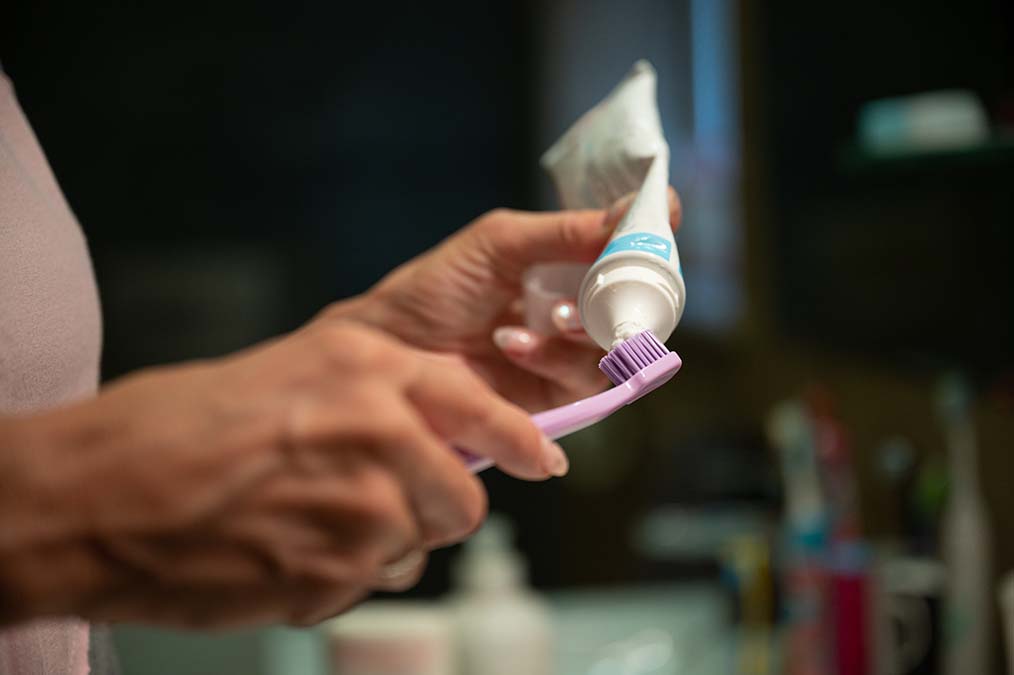You open the bathroom drawer and find “fluoride” in almost every toothpaste. Some applaud, others frown. Between promises and fears, the simple question remains: what is the right dose—and how safe is it here in Portugal? The good news is that we no longer need to navigate through opinions. Science and national and European recommendations are clear, as long as you respect two key ideas: frequent, low-dose contact and age-appropriate amounts.
Why does fluoride work?
There are no tricks. Fluoride acts mainly on the surface of the tooth, in this daily cycle of mineral loss and gain. When enamel suffers an “acid attack” (meals, sugary/acidic drinks), it loses calcium and phosphate. When you brush with fluoride toothpaste, you leave a thin “film” that helps to reincorporate these minerals and form more resistant crystals. At the same time, fluoride slows down demineralization in subsequent attacks and hinders the production of acid by cariogenic bacteria. What is the result? Less tooth decay over time, especially when fluoride is present every day, twice a day. The effect is predominantly topical: what matters is what stays in the mouth, not “what enters the body.”
The right dose for each age group: the consensus that matters
In Portugal, guidelines are in line with European evidence. For young children, the focus is on using enough toothpaste to protect their teeth, but not so much that they swallow too much. Until around the age of three, the recommendation is to use toothpaste with around 1000 ppm of fluoride, in an amount equivalent to a “grain of rice” and always under adult supervision. From 3 to 6 years old, the range of 1000–1450 ppm is maintained, now in a “pea-sized” portion and already training the child to “spit without swallowing.” From the age of six—and in adults—the reference becomes straightforward: 1450 ppm, applied in a thin line along the bristles. In situations of high risk of caries (history of lesions, orthodontics, dry mouth, very sugary diet), the professional may recommend higher concentrations or varnishes applied during the consultation. The pattern repeated in the literature is clear: ≥1000 ppm is the threshold above which consistent reductions in caries occur when compared to fluoride-free or very low-fluoride toothpastes.

Persistent myths… and what the data shows
“Fluoride toothpaste is harmful because it enters the body.” Brushing is brief contact; most of it is spat out, and the remainder is minimal. Using the appropriate concentration and the right amount, the systemic risk is very low. “It’s better without fluoride for children.” Precisely at the ages when the risk of tooth decay is highest, removing fluoride increases the likelihood of lesions. The risk-benefit balance clearly favors fluoridated toothpaste with a controlled dose. “In Portugal, the water already has enough fluoride.” Here it is important to be factual: Portugal does not practice community water fluoridation for caries prevention. The fluoride content in the public water supply is monitored for water safety, not as a preventive policy — it varies naturally and within quality limits. Prevention in Portugal is based mainly on fluoride toothpaste and, in clinical contexts, on professional applications when indicated.
Security: what we really need to watch out for
When it comes to fluoride, the main concern is usually dental fluorosis—a cosmetic change (white spots, sometimes discreet) that results from chronic excessive intake during enamel formation. This risk can be almost completely mitigated by following two simple rules: use toothpaste with the recommended concentration and in the right amount, under supervision in younger children. As for swallowing toothpaste, small amounts are ingested; the goal is to reduce this by teaching children to spit it out, avoiding large portions, and keeping the toothpaste out of reach. Professional varnishes and gels have high concentrations, but they are applied by trained teams, in controlled protocols, and with a good safety profile when used correctly. Finally, a useful note: the fluoride content in bottled water can vary—if a young child always consumes the same brand, it is worth reading the label and discussing any questions with a healthcare professional.
How to apply it in your daily life (without complicating things)
Protection comes from consistent habits, not from “weekend heroes.” Brushing twice a day for two minutes each time, with toothpaste in the right concentration for your needs, does most of the work. In the end, there’s no point in “washing” your mouth vigorously: spit out the excess and leave a thin film of fluoride to work for a few more minutes. Dental floss or interdental brushes are not “optional”; they allow fluoride to reach the spaces between teeth, where cavities like to start. If you tend to snack on acidic drinks throughout the day, try to concentrate these exposures, drink water afterwards, and wait 20–30 minutes before brushing. If you have dry mouth, chewing sugar-free gum for a few minutes after meals helps saliva—and fluoride—do its job better. For children, supervised brushing should continue until they have consistent dexterity; for adults, don’t underestimate exposed roots or extensive restorations: they still benefit from the same logic of frequent contact.
Conclusion
Fluoride is not a fad, it is physiology applied to tooth enamel. It works when used sparingly, but often, with the right concentration and dose appropriate to age and risk. In Portugal, where water is not fluoridated to prevent tooth decay, the difference is mainly in the brushing routine and, when indicated, in professional applications. Myths complicate things; practice simplifies them: using fluoride intelligently protects teeth and roots, reduces future restorations, and saves unnecessary discomfort.
References
https://www.omd.pt/content/uploads/2017/12/dgs-circular-normativa-01dse-2005.pdfhttps://www.eapd.eu/uploads/files/EAPD_Fluoride_Guidelines_2019.pdf
https://www.cochranelibrary.com/cdsr/doi/10.1002/14651858.CD007868.pub3/full
https://www.aapd.org/media/Policies_Guidelines/BP_FluorideTherapy.pdfhttps://rea.apambiente.pt/content/%C3%A1gua-para-consumo-humano



